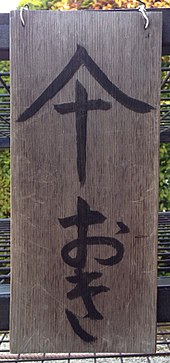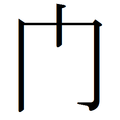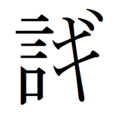Ryakuji


 |
| Japanese writing |
|---|
| Components |
| Uses |
| Transliteration |
InJapanese language,Ryakuji(Japanese:Lược tự"abbreviated characters", orBút viết lược tựhissha ryakuji,meaning "handwritten abbreviated characters" ) are colloquial simplifications ofkanji.
Status[edit]
Ryakuji are not covered in theKanji Kentei,nor are they officially recognized (most ryakuji are not present inUnicode). However, some abbreviated forms ofhyōgaiji(Biểu ngoại tự,characters not included in thetōyōorjōyō kanjilists) included in theJISstandards which conform to theshinjitaisimplifications are included in Level pre-1 and above of the Kanji Kentei (e.g.,Bính→Bánh,Quặc→Quặc), as well as some other allowances for alternate ways of writingradicalsand alternate forms. Some ryakuji were adopted as shinjitai.
Some simplifications are commonly used as specialJapanese typographic symbols.These include:
- 々,thekanji iteration mark,fromĐồng,a variant ofCùng;
- 〻,the vertical form, fromNhị;
- thehiragana and katakana iteration marks,ゝandヽ,generic strokes;
- 〆,shime,simplification ofChiếm(asChiếm め しめshime) as cursive form of top componentト,used for various kanji read asしめshime,primarilyĐính め,alsoBế め,Giảo め,Trá め,and originalChiếm め;
- ヶ,smallke,simplification ofCái(also used forCái), though with other uses.
Of these, only〆forĐínhandヶforCáiare generally recognized as being simplifications of kanji characters.
Replacements of complex characters by simpler standard characters (whether related or not) is instead a different phenomenon,kakikae.For example, in writingNăm linh 43 tuếasNăm lệnh 43 mới(nenrei 43 sai"age 43 years" ),Linhis replaced by the componentLệnhandTuếis replaced byMới,in both cases with the same pronunciation but different meanings. The replacement ofLinhbyLệnhis a graphic simplification (keeping the phonetic), whileTuếandMớiare graphically unrelated, but in both cases this is simply considered a replacement character, not a simplified form. Other examples include simplifying醤 dushōyu(soy sauce) toChính du.
Compare this tosimplified Chinese.
Use[edit]
Ryakuji are primarily used in individualmemos,notes and other such forms ofhandwriting.Their use has declined in recent years, possibly due to the emergence of computer technology and advanced input methods that allow equally fast input of both simple and complex characters. Despite this, the ryakuji forMôn(mon,kado;gate) and for characters using the radicalMônare still widely used in handwriting.[1]
Abbreviations for multiple-character words or phrases[edit]
In all cases discussed in the other sections of this article, individual characters are simplified, but separate characters are not merged. There are rare cases of single-character abbreviations for multiple-character words or phrases, such asĐồ-thư-quánforThư viện,Đồ thư quántoshokan,"library", but this is very unusual; seepolysyllabic Chinese charactersfor this phenomenon in Chinese, where it is more common.
Examples[edit]

Notes[edit]
Of these, several are commonly seen in signs:Môn(2),Phẩm(12),Khí(12) are very commonly seen, particularly simplifyingGianin store signs, whileĐệ(1) andDiệu(5) are also relatively common, as is𩵋forCá(as inĐiểm(3)). Other characters are less commonly seen in public, instead being primarily found in private writing.
- 1 and 2. (Đệ,Môn– These are perhaps the most commonly used Ryakuji. 1 (dai,ordinal prefix) is present inUnicodeasU+3427(㐧), but is not supported by theMS GothicorMinchofamily of typefaces, orArial Unicode MS.According to the original Japanese article, 1 has been seen on roadsigns on the Keihin #3 Road (㐧 tam kinh bang con đường,Dai-San Keihin Dōro). 2 is present in Unicode asU+95E8;it is unified with the closely relatedSimplified ChineseabbreviationMôn(both originated fromcursive scriptforms). The Japanese form may be explicitly induced with the sequence U+95E8 U+E0100.
- 3. (Điểm) – An abbreviation of the bottom four dots in the characterĐiểmis present inUnicodeas奌U+594C,but is not supported by the MS Gothic or MS Mincho typefaces. It does appear in Arial Unicode, Sim Sun, Sim Hei, MingLiU, KaiU and New Gulim typefaces. Another simplification of this sort can be seen for the bottom four dots ofCá(present in Unicode as𩵋U+29D4B). The bottom of the charactersNhiệtandMã,however, are simplified instead using a horizontal line, as in the Simplified Chinese charactersMãandCá.
- 4. (Chức) (variant 1 is present in Unicode asU+803A;variant 2 isU+2B7C9) – Also used often, but somehow not applied to the related charactersDệtandThức.
- 5. (Diệu)
 (⿰ ngày ngọc,fromDiệu = ⿰ ngày địch) (present in Unicode as𫞂U+2B782) – Also often written asVượng(originally a different character), but the dot (as inNgọc) is used to distinguish. Common abbreviation in stores for days of week. The phoneticĐịchis generally not abbreviated to ngọc in other character such asTrạc,Trạc,Trạo,Nhảy,Diệu,orDiệu.
(⿰ ngày ngọc,fromDiệu = ⿰ ngày địch) (present in Unicode as𫞂U+2B782) – Also often written asVượng(originally a different character), but the dot (as inNgọc) is used to distinguish. Common abbreviation in stores for days of week. The phoneticĐịchis generally not abbreviated to ngọc in other character such asTrạc,Trạc,Trạo,Nhảy,Diệu,orDiệu. - 6. (Trước) – Grass script form (1 and 2 also originated from grass script forms)
- 7. (Cái) (present in Unicode as㐰U+3430) – Abbreviated by removing the contents of thekunigamae( cố ) component. There is also theVi(U+56D7) abbreviation forQuốc.
- 8 and 10. (TuyểnCơ,not present in Unicode) – A portion at the top consisting of two or more consecutive characters is changed to a⺍shape. This can be seen in the Shinjitai simplificationsVinh → vinh,Đơn →単,Nghiêm → nghiêm,Sào →巣,Học → học.TheTrúctop radical has also been used (although rarely). A colloquial simplification forCơexists (not present in Unicode) in which the right portion is replaced bykatakanaキ(ki) to indicate theonreading.
- 9. (Lự) (present in Unicode asHỗU+6CAA) – Not as common a character, but a major ryakuji in scientific circles, as it is used in such words asLự quá(roka,percolation). This character has also been seen in print. The componentLư,pronouncedROjust likeLự,is commonly simplified toHộas well such as inLô → lôand the Shinjitai simplificationLò → lò.
- 11.ĐấutoĐấu(⿰ môn đấu) or simplyĐấu(in Unicode atU+9597). The complicated characterĐấu(tō) is replaced by a simpler character of the sameOn reading,Đấu.This is formally known askakikae,if one standard character is replaced by another standard character of the same reading, though hybrids such asĐấu ( môn đấu )are ryakuji. Another example of kakikae isNăm linh 43 tuế → năm lệnh 43 mới(nenrei43sai"age 43 years" ), and simplifications of this method have also been seen in print.
- 12. (Phẩm,Khí) (present in Unicode as 𠯮U+20BEE) – Also commonly seen. The bottom吅portion ofPhẩmis merged. Examples have also been seen in characters such asLinh(the Kyūjitai ofLinh) in which the𠱠portion has been merged.
- 13.Ma,Ma(not present in Unicode) – A colloquial simplification in whichkatakanaマ(ma) is used to indicate theonreading of both characters (ma). The simplification forMais seen inmanga,and the simplification forMais commonly seen when writing place names such asTama, Tokyo(Nhiều ma thị).
Further examples[edit]
Omitting components is a general principle, and the resulting character is often not a standard character, as inDù → tản.
If the resulting character is a standard character with the same reading (common if keeping the phonetic), this is properlykakikaeinstead, but if it is simply a graphic simplification (with a different reading) or the resulting character is not standard, this is ryakuji. One of the most common examples isKhănforPhúchaba"width". Often the result would be ambiguous in isolation, but is understandable from context. This is particularly common in familiar compounds, such as in the following examples:
- Linh → lệnhinNăm linh → năm lệnh
- Lịch → xưởnginLịch sử → lịch sử nhà máy
- Kinh → thánhinKinh tế → thánh tế
In some cases, a component has been simplified when part of other characters, but has not been simplified in isolation, or has been simplified in some characters but not others. In that case, simplifying it in isolation can be used as common ryakuji. For example,Tốtis used in isolation, but in compounds has been simplified toTốt,such asSaytoTúy.UsingTốtin isolation, such as when writingTân tốtshin-sotsu"newly graduated" asTân tốt,is unofficial ryakuji. As another example,Chuyênhas been simplified toVânin some characters, such asTruyềntoVân,but only toChuyênin isolation or other characters. Thus simplifying theChuyêninMỏng(bottom partPhổ) toVânis found in ryakuji.
More unusual examples come from calligraphic abbreviations, or more formally from printed forms of calligraphic forms: a standard character is first written in a calligraphic (Lối viết thảo,grass script) form, then this is converted back to print script (Thể chữ Khải) in a simplified form. This is the same principle as graphical simplifications such asHọc → học,and of various simplifications above, such asĐệ →㐧.A conspicuous informal example isHỉ →㐂(3 copies of the character for 7:Bảy), which is rather frequently seen on store signs. Other examples includeLộc →𢈘;and replacing the center ofPhongwith two,,as in the bottom ofĐông.Ngựhas various such simplifications. InNiigata(Tân tả), the second characterTảis rare and complex, and is thus simplified asTả → tả ( thủy viết ).
Derived characters[edit]
Derived characters accordingly also have derived ryakuji, as in these characters derived fromMôn:
-
Môn
-
Gian
-
Khai
Similarly, theCá →𩵋simplification is often used in fish compounds, such asNghệsushi,particularly in signs.
Phonetic simplifications[edit]
Some ryakuji are simplifiedphono-semanticcharacters, retaining a radical as semantic and replacing the rest of the character with akatakanaphonetic for theonreading, e.g.,Nghị(20 strokes) may be simplified asNgôn(semantic) +ギ(phoneticgiforonreading):
Another example isTầngsō,replacing theTằngbyソso.
This may also be done using Latin characters; for example, the characterHiến(as used inHiến phápkenpō,"constitution" ) may be simplified to "Miên K":the radicalMiênplaced over the letter K; this is particularly common in law school. Similarly,Khánh ứng(Keiō) as inKeio Universitymay be simplified to "Quảng K quảng O":the letters K and O respectively placed inside the radicalQuảng.In this case the pronunciation of "KO"(as aninitialism) sounds like the actual name "Keiō", hence the use.
The characterCơhas a number of ryakuji, as it is a commonly used character with many strokes (16 strokes); in addition to the above phono-semantic simplification, it also has a number of purely graphical simplifications:
-
Mộc + キ
See also[edit]
- 〆,shime,simplification ofChiếm(asChiếm め しめshime)
- ヶ,smallke,simplification ofCái
- Kana ligature
- Shinjitai
- Simplified Chinese character
- Variant Chinese character
- Yakja,Korean simplifications
References[edit]
- ^"Thường dùng chữ Hán biểu の tự thể ・ hình chữ に quan する kim đồng hồ ( báo cáo ) について"(PDF).Agency for Cultural Affairs. p. 73.Retrieved6 December2019.
This articleneeds additional citations forverification.(March 2011) |
- Spahn and Hadamitzky,The Kanji Dictionary,ISBN978-0-8048-2058-5










